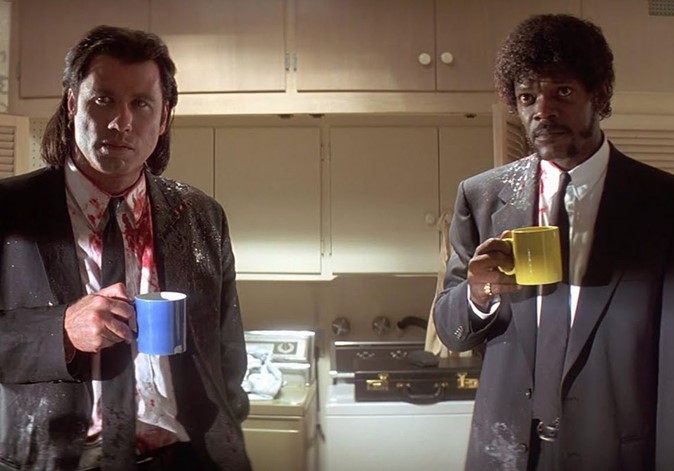
For the first semester of 2024, the UQ Film Appreciation Society (UQFAS) will screen a selection of 1990s films. These include familiar favourites T2: Judgement Day (1991), 10 Things I Hate About You (1999), and Fight Club (1999), alongside arthouse picks such as Trainspotting (1996), Boogie Nights (1997), and The Thin Red Line (1998), and a smattering of international films like Princess Mononoke (1997) and Kuch Kuch Hota Hai (1998). But this begs the question – what is so special about 90s cinema?
The 1990s were the backdrop to a wild variety of films. Many remember it for the Disney Renaissance incited by The Little Mermaid in 1989, which produced beloved classics Beauty and the Beast (1991), Alladin (1992), and The Lion King (1994), and revived the animated musical. Then, following breakthroughs in CGI, Toy Story (1995) marked a paradigm shift in animation. Digital animation using 3D models monopolised the dominant animation style for over 20 years until Spider-Man: Into the Spider-Verse (2018) innovated stylistically. Advances in CGI and visual effects also saw its fair share of box office hits. From the prehistoric thrill of Spielberg’s Jurassic Park (1993) to the sinking of James Cameron’s Titanic (1997) to the digital flair of the Wachowski’s The Matrix (1999), spectacle was the name of the game and CGI was integral to crafting set pieces bigger than Ben-Hur.
However, ask anyone to name the definitive movie of the decade and the response is invariable – Pulp Fiction (1994). Toying with traditional narrative structures alongside effortlessly sharp dialogue and editing, Pulp Fiction redefined how a mainstream hit looked. A young director working at the grassroots, Quentin Tarantino dominated the cinema zeitgeist of the 90s, also releasing Reservoir Dogs (1992) and Jackie Brown (1997) during this time. Indeed, the 90s were a breeding ground for emerging directorial talent: if the 30s and 40s were the Golden Age of Hollywood, the 90s were the Golden Age of Indie. Beginning with Steven Soderbergh’s Sex, Lies, and Videotape (1989), many of today’s most influential directors made their name around this time, from Spike Lee with Do the Right Thing (1989), Richard Linklater with Slacker (1990), Jane Campion with The Piano (1993), Kevin Smith with Clerks (1994), Paul Thomas Anderson with Hard Eight (1996), Wes Anderson with Bottle Rocket (1996), Danny Boyle with Trainspotting (1996), Darren Aronofsky with Pi (1998), Sofia Coppola with The Virgin Suicides (1999), the list truly goes on and on.
But one may astutely ask: why was this era of film history so fruitful for independent directors? Well, unsurprisingly, the answer comes down to money. Never had indie filmmaking been so commercially viable. As camera and equipment costs continued to drop, more young auteurs were putting their aspirations to film. Festivals such as Sundance, an epicentre of independent film, offered a vital platform for these directors to showcase their work, while studios like Miramax marketed the films to the public. Meanwhile, the advent of home video opened a crucial second market for films to recoup their budget (in fact, home video sales often eclipsed the theatrical run), while offering an outlet for a much wider audience to enjoy more experimental, stylised outings.

Interestingly, the 90s Golden Age of Indie is indicative of a larger indie-blockbuster cycle. Throughout cinema history, both large blockbusters and smaller indie projects are ever present, however, different periods see the two enjoy different degrees of success. The 50s and 60s were the age of the blockbuster as Ben Hur (1959), West Side Story (1961), Cleopatra (1963), and The Sound of Music (1965)pushed cinema to unrivalled heights of popularity. After a string of commercial failures, in the 70s studios diversified their output and looked to budding talents such as Francis Ford Coppola, Steven Spielberg, Martin Scorsese, and George Lucas to recapture people’s attention. Following initial independent efforts, these directors garnered studio backing to break into the mainstream with hits like The Godfather (1972), Jaws (1975), Taxi Driver (1976), and Star Wars (1977) respectively. Building off this success, the 80s ushered in the new era of the blockbuster, where Star Wars: The Empire Strikes Back (1980), Raiders of the Lost Ark (1981), Back to the Future (1985), Top Gun (1986) and the Brat Pack reigned supreme.
Again, as the 80s wore on blockbusters wore thin (Days of Thunder (1990) especially is a notable flop), and by the 90s we were ready for an indie revival. The 2000s were then a return to form as 90s indie talents made bigger movies on studio-sized budgets. However, reboots and franchise media has seen this blockbuster era, from Transformers in the 2000s to the monolithic MCU of the 2010s, overstay its welcome. Despite this, the indie scene has revitalised in recent years with A24 and budding talents like Greta Gerwig, Chloe Zhao, Barry Jenkins, Ari Aster, Celine Song, Emerald Fennel, and Charlotte Wells playing with the medium to authentically explore contemporary issues.

Although the future of indie is promising, with Marvel’s decreasing popularity following Avengers: Endgame (2019) and streaming making indie more accessible than ever, the independent scene still must overcome several modern obstacles. Foremost is the paradox of streaming, a model compensating directors in exposure more than revenue. New directors face unprecedented popularity, but for a much lower price. Additionally, studio headhunting is rampant. Previously, studio funding allowed directors the freedom to express themselves with bigger projects. However, emerging directors now often find themselves at the helm of studio blockbusters, with heavily restricted creative control while studios profit off their cult followings, exemplified by Chloe Zhao’s straw-manning by Marvel with The Eternals (2021) and Greta Gerwig’s Mattel success with Barbie (2023).
Ultimately, what does 90s cinema represent? Well, it represents the cinema of the independent, a return to grassroots filmmaking that saw an unprecedented proliferation of unique perspectives and idiosyncratic stylings. Additionally, the 90s also offers insight into the tides of cinema history. It gives modern audiences hope the reboot hell of the last decade will finally be overthrown by a revival of independent film, however, the filmmaking climate of late offers its own unique challenges. In the end, perhaps Pulp Fiction is more emblematic of the 90s than we may have expected!
If you want to attend a UQFAS screening, please visit https://www.uqu.com.au/club/uq-film-appreciation-society-uqfas or find us on Facebook at https://www.facebook.com/uqfas for more information.
Memberships cost less than $10 for the entire year and give you access to over 35 screenings!
References
https://en.wikipedia.org/wiki/1990s_in_film
https://www.filmsite.org/90sintro2.html
https://movieweb.com/why-90s-greatest-decade-movie-history/
Image Credits
https://www.flickr.com/photos/photographingtravis/18118961764
https://lwlies.com/articles/lady-bird-behind-the-scenes-clip-greta-gerwig/
Views: 58
